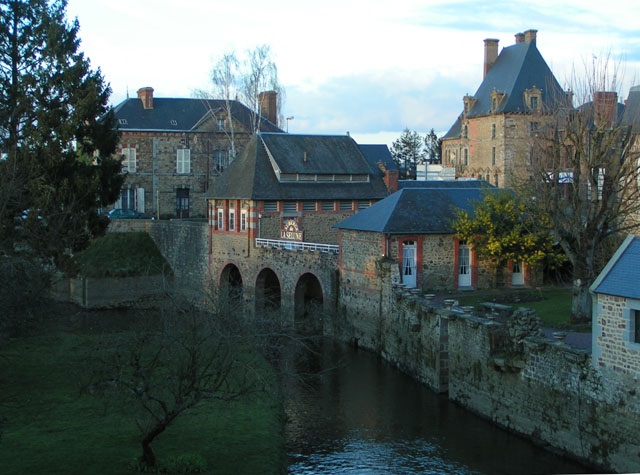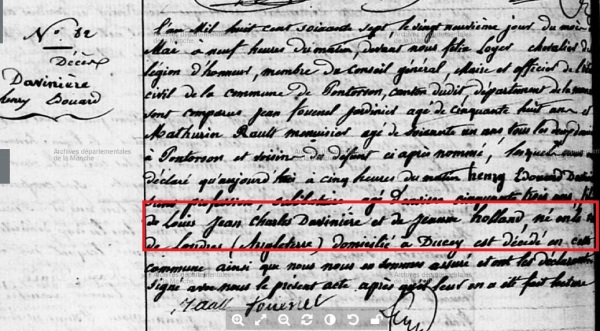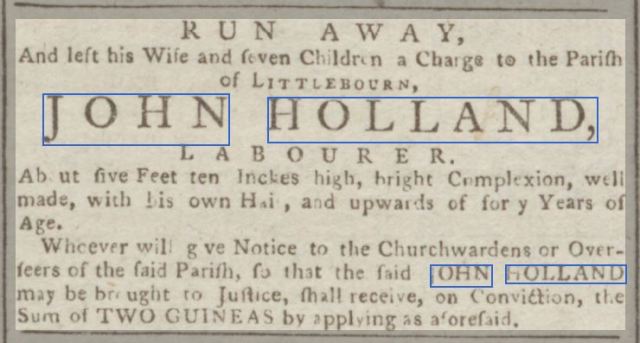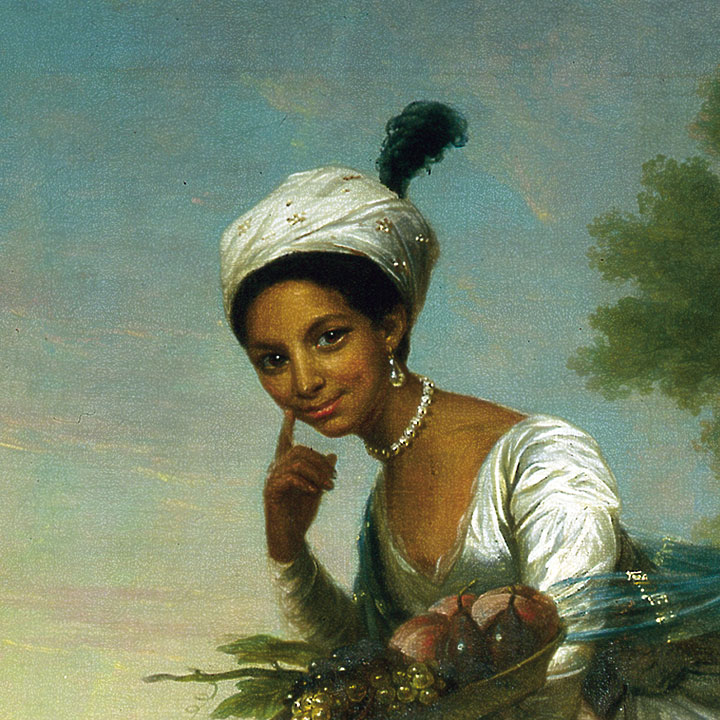As many readers are aware, over the past few months I have been researching the life of Dido Elizabeth Belle and her family, in addition to the usual eclectic mix of posts. Some information about her life has now been in the public domain for a number of years, including the film made about her life, ‘Belle‘, but since this quest began it has been possible to uncover some new pieces of information about her life, that of her siblings and her husband, and of course, there’s been renewed interest in her since the BBC programme about the painting itself.
Today I would like to share some more information received from one of my lovely readers, Chris Goddard, about John Davinière, and with the help of Chris, it has also been possible to begin to piece together a little more of what became of the Davinière family when they returned to France in around 1830, long after the death of Dido.

We know that John, his second wife Jane nee Holland and their son Edward returned to John’s place of birth, Ducey, France and that Edward returned to England on 24 August 1837, briefly to witness his half brother’s marriage in London.
The newspapers in France confirm that their son, Edward was involved in an incident and that Edward Henry Davinière, aged 30, described as a medical student at the time, was forcibly committed to an asylum in Dinan, as he had threated to ‘blow out the brain‘ of the mayor of Ducey and that he made threats against the mayor’s wife and her servant, following arguments with his father. Was Edward Henry mentally unstable, was that possibly their reason for leaving England in the first place? This new piece of information brings with it its own questions for which more research is still required.
It would appear that perhaps in light of this incident, John felt it was time for a move, so advertised his beautiful house for sale.
Beautiful property for sale presently. It consists of a superb mansion, with kitchen, dining room, living room, three bedrooms, three closets and an attic; it is freshly parqueted, panelled, painted and carpeted – a laundry, cellars, shed, stable, wine press, vault and latrine; a garden, fruit and vegetable garden and an orchard; in total about eighty acres, is closed by beautiful hedges of bleached thorns, and is located near the village of Ducey, a very small distance from the departmental road of Alençon to St Malo. The house is furnished with a rich new furniture, that will be sold with the house if the purchaser wishes. To visit this property and discuss the price, contact Davinière who occupies it.
John’s death certificate confirms that he died 31 March 1847 at his home in Ducey and names his late parents as Charles and Madeleine, his wife as Jane nee Holland. There was also a nine page inventory of his possessions.

It is known from these documents that he left a widow Jane, a landowner/annuitant (le rentière) and their son Edward in France, and that their daughter Lavinia Amelia was living with her husband family in London, but until now it wasn’t known for certain whether mother and son remained in France. It appears that they did, as Jane appeared in January 1851, on a type of ‘census’ for Avranches, just a few miles from Ducey, no further information provided, just her name as the widow of Davinière.
Jane (or Jeanne Holland), as she was referred to, (the French helpfully use a woman’s maiden name on death certificates), died at her home on Rue Ormont, Avranches, France in March 1851, at which time all her household belongings were sold off.
The death certificate gave her age as 53, this can’t possibly have been correct, given the ages of her children – Lavinia would have been 39 and Edward, 41 by that time. Perhaps a lady never tells her true age or it was simply an error made on the death certificate, but I suspect at this stage that 63 would appear much closer to the truth.(See below for another update – we now know her true age).
Her death certificate recorded her name as Jeanne Marie rather than simply Jeanne (Jane), which is very strange, especially as fortunately for us, there are a copious number of documents which referred to her as simply Jane (she was a genealogist’s dream!), including her: baptism, marriage, the baptism of her children, her name on her husband’s death certificate:

Her signature on her husband’s inventory, an advert for the sale of her house, and later her name noted on her sons death certificate.

Quite who added the Marie to her name is unclear, but given all information to the contrary, my opinion is that it was a mistake, unless she changed after her husband’s death which seems unlikely. Etienne Daly is insistent however, that she should be known as Jane Mary, as it appeared her death certificate and therefore is the opinion that Jane Mary must be correct.
On 21st April 1851, the late Jeanne Holland, widow of Louis Jean Charles Davinière’s house and possessions were sold off. After his mother’s death, Edward was placed in the asylum in Pontorson (about a 15 minute drive from Ducey) during which time there was a guardianship case involving his sister who lived in England.

Edward Henry died at Pontorson on 29th May 1867.


An update to the update (16 September 2022). I have finally managed to find Jane’s death notice in the French archives which confirms that she was born at Littlebourne, Kent and as we can see below, she was baptised at the parish church, on 19 May 1782, daughter of John and Jane Holland (nee Fox) which again matches the information provided on the notification of death (her mother being clearly named as Jane nee Fox), making Jane 14 years John’s junior.

Jane was one of at least 7 children and as can be seen below, their father, a labourer, abandoned the family when Jane was just one year old leaving her mother to seek assistance from the parish. This seems to indicate that Janes social status was very different to that of John’s first wife. As yet there’s no explanation as to how Jane ended up in London, but it would seem likely that she was sent there to work, perhaps as a maid. When she married John she was able to sign the marriage register, but whether that was the extent of her written ability remains unknown.

At this stage, with the continued interest in the life of Dido, I thought it might be a good idea to provide links to all the individual articles under one roof. This will no doubt be added to as more information comes to light, so please do feel free to check back from time to time.
Dido Elizabeth Belle and John Davinière, what became of them?
The Descendants of Dido Elizabeth Belle
Dido Elizabeth Belle: Questions and Answers
Dido Elizabeth Belle – New information about her siblings
Dido Elizabeth Belle – Ranelagh Street, Pimlico
Dido Elizabeth Belle – A new perspective on her portrait
The missing brother of Sir John Lindsay
Dido Elizabeth Belle portrait – BBC Fake or Fortune
The Eighteenth-Century Fashion for Turbans
An Eighteenth-Century game of ‘Degrees of Separation’
Is Dido Elizabeth Belle still buried at St George’s burial ground in Bayswater Road?
Where are Dido Elizabeth Belle’s sons buried?
Who lived in these houses on Hertford Street, Mayfair?
Other articles/books that have been written about Dido and/or her family in the past, but which contain out of date information, but which you might find of interest are:
Adams, Gene. Dido Elizabeth Belle: a black girl at Kenwood: an account of a protégée of the 1st Lord Mansfield
Byrne, Paula. Belle: The True Story of Dido Belle
Gerzina, Gretchen. Black London: Life before Emancipation
Heward, Edmund. Lord Mansfield
Minney, Sarah. Inside Out: Abolition of the British Slave Trade special
Stringfield, Margo. Real Story of ‘Belle’ has Pensacola Connections
There are also numerous blogs and books in addition to mine that have told part of Dido’s story which I’m sure you will find with a quick online search.
If you have any questions or any additional information about Dido I would love to hear from you. New snippets of information seem to be appearing almost daily, which is great news as they all help to provide a more accurate and detailed account of her life and that of her family.
* I should also like to acknowledge Judy Jerkins who started the ball rolling with her research into the life of Courtoy and David Godson who has written an account of Courtoy’s life.
Header Image
Dido Elizabeth Belle. The portrait hangs at Scone Palace in Perthshire.

